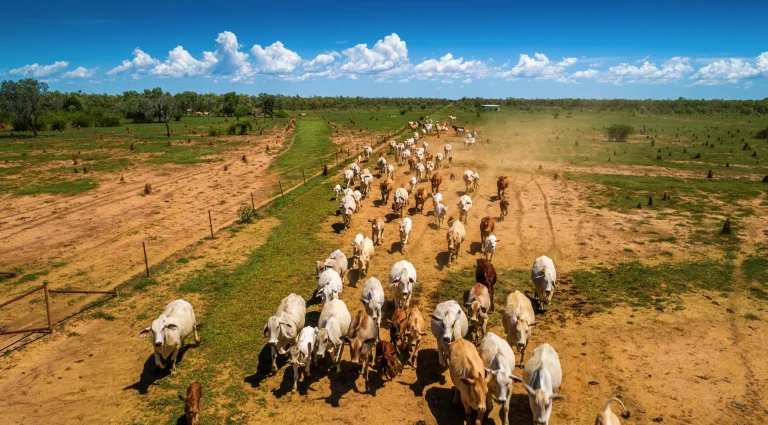A Guide for US Investors: Comparing Australian and American Farmland Returns
The global search for agricultural investment opportunities has led sophisticated US investors to examine farmland markets beyond American borders, with Australia emerging as a compelling alternative destination. This comprehensive guide for US investors comparing Australian and American farmland returns examines the fundamental differences, strategic advantages, and investment considerations that distinguish these two premier agricultural markets from investor perspectives.
American investors increasingly recognize that geographic diversification through international farmland exposure can enhance portfolio performance while providing access to different production systems, climatic conditions, and market dynamics. Australian agricultural properties offer unique characteristics including counter-seasonal production cycles, diverse crop opportunities, and stable regulatory environments that complement domestic US agricultural investments.
The complexity of cross-border agricultural investment requires thorough understanding of market structures, regulatory frameworks, currency considerations, and operational differences that affect both immediate returns and long-term investment outcomes. At Agribusiness Horizons, we regularly provide guidance for US investors comparing Australian and American farmland returns, helping American capital navigate the opportunities and challenges of international agricultural property investment.
This detailed analysis will examine comparative market characteristics, return profiles, risk factors, and strategic considerations that enable informed decision-making for US investors considering Australian farmland as part of their agricultural investment strategies.
Market Structure and Investment Environment Comparison
Australian and American farmland markets demonstrate distinct structural characteristics that create different investment environments and return profiles for institutional and private investors seeking agricultural exposure across these major agricultural economies.
The Australian farmland market operates within a more concentrated agricultural sector with fewer but larger agricultural enterprises compared to the fragmented structure common in many American agricultural regions. This concentration often provides clearer market signals and more straightforward transaction processes for significant agricultural acquisitions.
Regulatory frameworks governing farmland ownership and operation differ substantially between countries, with Australia’s Foreign Investment Review Board creating specific approval processes for international investment while providing clear guidelines and transparent assessment criteria that facilitate strategic planning.
Market liquidity patterns vary between Australian and American agricultural property markets, with certain Australian regions demonstrating active transaction volumes while other areas experience limited trading activity. American farmland markets generally provide greater liquidity in established agricultural regions but may face greater competition from urban development pressures.
Professional service availability and market infrastructure support different investment approaches, with Australia’s specialized agricultural advisory sector providing comprehensive international investor support while American markets offer extensive domestic expertise and established investment platforms.
Currency dynamics and exchange rate considerations create additional complexity for US investors in Australian farmland, potentially providing both hedging benefits and additional volatility that affect overall investment returns and strategic planning requirements.
Property scale and operational characteristics often differ between Australian and American agricultural systems, with Australian properties frequently offering larger operational scales and different management intensities that affect both capital requirements and operational approaches.
Regional Opportunities and Comparative Advantages
Both Australian and American agricultural regions provide distinct investment opportunities with varying risk-return profiles that appeal to different investor strategies and portfolio objectives seeking geographic and production system diversification.
Australia’s diverse climatic zones create year-round production opportunities that complement seasonal American agricultural cycles, potentially providing portfolio diversification benefits and counter-cyclical cash flow patterns that enhance overall investment stability and risk management.
Premium Australian agricultural regions including Victoria’s high-rainfall areas, Queensland’s diverse cropping zones, and New South Wales irrigation districts offer established infrastructure and proven productivity that compares favorably with premier American agricultural areas.
American agricultural regions provide extensive scale opportunities and established market infrastructure with direct access to major commodity markets and processing facilities that support efficient operations and competitive positioning in global markets.
Water security considerations affect both Australian and American agricultural investments differently, with Australian irrigation developments often providing greater operational security while American properties may face increasing water allocation challenges in certain regions.
Soil quality and productive capacity variations across both countries create opportunities for strategic property selection based on specific production objectives and return expectations that align with different investment strategies and risk tolerances.
Technology adoption and precision agriculture implementation vary between regions in both countries, with leading areas in each market demonstrating sophisticated production systems that enhance efficiency and competitive positioning for progressive agricultural investments.
Return Profile Analysis and Investment Characteristics
Understanding the fundamental return characteristics of Australian versus American farmland requires comprehensive analysis of income generation potential, capital appreciation trends, and risk-adjusted performance across different property types and regional markets.
Agricultural productivity and yield potential create the foundation for income returns in both markets, with Australian properties often demonstrating consistent production under favorable climatic conditions while American properties may offer higher absolute yield potential in premium regions.
Cash flow patterns and seasonal variations differ between Australian and American agricultural systems, with counter-seasonal production cycles potentially providing portfolio optimization benefits for US investors seeking to smooth income generation across calendar years.
Capital appreciation trends reflect different market dynamics and development pressures, with Australian agricultural land demonstrating steady appreciation supported by domestic demand and international investment interest, while American farmland values respond to local development pressure and agricultural market conditions.
Market volatility and return stability patterns vary between the two markets based on different economic cycles, commodity market exposure, and regulatory influences that affect both short-term performance and long-term investment security.
Operating expense structures and cost management opportunities differ between Australian and American agricultural operations, reflecting different labor markets, input costs, and regulatory requirements that affect net income generation and return optimization.
Tax implications and investment structure considerations create different after-tax return profiles for US investors, with Australian investments requiring careful structure planning to optimize tax efficiency while maintaining compliance with both countries’ taxation requirements.
Currency and Economic Considerations
Currency exposure through Australian farmland investment creates both opportunities and risks for US investors that require careful consideration within overall portfolio strategy and risk management frameworks.
Exchange rate volatility between the US dollar and Australian dollar affects both investment returns and operational cash flows, potentially providing portfolio diversification benefits while creating additional uncertainty that requires strategic management approaches.
Economic cycle differences between Australia and the United States may provide portfolio diversification advantages through exposure to different interest rate environments, inflation patterns, and economic growth trajectories that affect agricultural market performance.
Commodity market integration and price relationships between Australian and American agricultural products create complex correlation patterns that affect return relationships and diversification benefits for investors seeking exposure to both markets.
Inflation protection characteristics of farmland investments may perform differently in Australian versus American economic environments, with varying effectiveness as inflation hedges based on different monetary policies and economic structures.
Interest rate sensitivity and financing cost considerations affect investment returns differently in each market, with Australian agricultural property financing often involving different term structures and cost patterns compared to American agricultural lending markets.
Political and policy stability factors influence long-term investment security and return predictability, with both countries providing stable investment environments but different policy approaches to agricultural sector support and international investment regulation.
Regulatory Framework and Investment Process Differences
Navigating the regulatory requirements for Australian farmland investment presents US investors with distinct processes and compliance obligations that differ substantially from domestic American agricultural property transactions.
Foreign investment approval processes through Australia’s Foreign Investment Review Board require advance planning and comprehensive documentation but provide clear pathways for compliant international agricultural investment with reasonable processing timeframes.
Ongoing compliance obligations for foreign agricultural property ownership in Australia include reporting requirements and operational restrictions that must be understood and managed throughout the investment period to maintain regulatory compliance.
Property acquisition processes and transaction procedures differ between Australian and American markets in terms of due diligence requirements, settlement procedures, and professional service arrangements that affect transaction timing and complexity.
Tax treaty arrangements between Australia and the United States provide frameworks for managing double taxation issues while optimizing overall tax efficiency for cross-border agricultural investments through appropriate structuring approaches.
Legal structure options and ownership arrangements offer different opportunities for US investors in Australian farmland compared to domestic investments, requiring specialized advice to optimize both regulatory compliance and investment returns.
Professional advisory requirements for successful Australian farmland investment typically involve specialized consultants familiar with international investment regulations and Australian agricultural markets, differing from domestic American investment advisory needs.
Risk Assessment and Management Strategies
Comprehensive risk evaluation for US investors requires systematic comparison of risk factors affecting Australian versus American farmland investments across multiple dimensions including operational, market, and regulatory considerations.
Political and regulatory risk profiles differ between countries based on government stability, policy predictability, and international investment attitudes that affect long-term investment security and operational continuity for foreign investors.
Climate and weather risk patterns provide both diversification opportunities and unique exposures for US investors in Australian farmland, with different seasonal patterns and extreme weather risks compared to domestic American agricultural investments.
Market risk factors including commodity price exposure, currency fluctuations, and demand patterns create different risk profiles for Australian investments compared to American agricultural properties, requiring specialized risk management approaches.
Operational risk considerations encompass management complexity, labor availability, and service provider access that may differ significantly between Australian and American agricultural operations, affecting both returns and risk management requirements.
Liquidity risk and exit strategy considerations vary between markets based on transaction volumes, buyer pools, and market conditions that affect portfolio management flexibility and strategic planning requirements for long-term agricultural investments.
Natural disaster and extreme event risks differ between Australian and American agricultural regions, with varying insurance availability and government support programs that affect risk management strategies and potential loss mitigation approaches.
Comparative Analysis of Investment Characteristics
| Investment Factor | Australian Farmland | American Farmland | US Investor Considerations |
|---|---|---|---|
| Market Access | FIRB Approval Required | Direct Access | Regulatory Complexity |
| Currency Exposure | AUD Denominated | USD Denominated | Diversification Opportunity |
| Seasonal Patterns | Counter-Seasonal | Domestic Alignment | Portfolio Optimization |
| Transaction Scale | Larger Properties | Variable Scale | Capital Requirements |
| Management Options | Professional Required | Multiple Options | Operational Complexity |
This analysis demonstrates how Australian and American farmland investments present different characteristics that require careful evaluation for US investors. A guide for US investors comparing Australian and American farmland returns must address these fundamental differences in market access, operational requirements, and strategic positioning.
Australian investments typically require greater regulatory navigation and professional management but may provide portfolio diversification benefits, while American investments offer direct market access and familiar operational environments with different risk-return characteristics.
Agribusiness Horizons’ US Investor Advisory Services
Our specialized expertise in international agricultural investment provides US investors with comprehensive advisory services that facilitate successful Australian farmland investment while ensuring optimal strategic positioning and regulatory compliance throughout the investment process.
Market intelligence and opportunity identification services leverage our extensive Australian agricultural network to identify investment opportunities that align with US investor criteria before properties reach broader market exposure, providing competitive timing and pricing advantages.
Regulatory navigation and FIRB approval support addresses all foreign investment requirements and compliance obligations while coordinating with US tax and legal advisors to ensure optimal investment structuring and ongoing regulatory adherence.
Technical due diligence coordination brings together Australian agricultural specialists, soil scientists, and infrastructure experts to provide comprehensive property assessment that meets US institutional investment standards while addressing Australian-specific factors.
Financial analysis and return modeling services examine Australian property performance using US investor criteria while incorporating currency considerations, tax implications, and comparative market analysis that supports informed investment decisions.
Strategic structuring and professional management facilitation connects US investors with optimal ownership arrangements and operational management services that ensure successful investment implementation and ongoing performance optimization.
Our understanding of the complexities involved in preparing a guide for US investors comparing Australian and American farmland returns enables us to provide targeted advisory services that address specific US investor needs while ensuring successful Australian agricultural property acquisition and management.
Strategic Implementation and Portfolio Integration
Successful Australian farmland investment for US investors requires systematic implementation approaches that integrate international property exposure with domestic agricultural investments and broader portfolio objectives.
Portfolio allocation strategies must balance Australian farmland exposure with domestic agricultural investments while considering correlation patterns, risk factors, and return optimization opportunities that enhance overall agricultural portfolio performance.
Currency hedging and risk management strategies address exchange rate exposure through various financial instruments and operational approaches that protect investment returns while maintaining upside potential from favorable currency movements.
Professional management arrangements and operational oversight ensure Australian agricultural properties maintain excellent performance standards while providing US investors with appropriate reporting and strategic input throughout the investment period.
Performance monitoring and comparative analysis systems track Australian investment outcomes against US agricultural benchmarks while providing ongoing strategic guidance for portfolio optimization and strategic adjustment.
Tax optimization and structure management coordinate Australian and US taxation obligations while maximizing available treaty benefits and maintaining compliance with both countries’ regulatory requirements throughout the investment lifecycle.
Exit strategy planning and liquidity management address potential disposition requirements and market timing considerations that optimize long-term returns while maintaining strategic flexibility for changing investment objectives.
Market Trends and Future Opportunities
Emerging trends in international agricultural investment continue reshaping opportunities for US investors considering Australian farmland exposure through evolving market conditions, regulatory frameworks, and strategic positioning opportunities.
Sustainability and carbon farming opportunities in Australian agriculture provide additional revenue streams and investment differentiation that complement traditional agricultural returns while supporting environmental objectives increasingly important to institutional investors.
Technology advancement and precision agriculture development create competitive advantages for Australian properties with modern infrastructure and sophisticated management systems that appeal to US investors seeking operational excellence and efficiency.
Trade relationships and market access developments between Australia, Asia, and global markets continue enhancing the strategic value of Australian agricultural investments for US investors seeking exposure to growing international food demand.
Climate adaptation and water security considerations become increasingly important for long-term investment success, with Australian properties demonstrating superior climate resilience and water security commanding premium valuations and strategic positioning advantages.
Supply chain integration and processing opportunities provide value-added potential through vertical integration strategies that capture additional margins while enhancing competitive positioning in target export markets.
Conclusion and Strategic Decision Framework
A guide for US investors comparing Australian and American farmland returns reveals compelling opportunities for geographic diversification while highlighting important considerations that require professional guidance and systematic implementation. Australian farmland provides unique characteristics that complement domestic US agricultural investments through counter-seasonal production, currency diversification, and access to growing Asian markets.
Successful international agricultural investment requires comprehensive understanding of regulatory requirements, market dynamics, and operational considerations that differ substantially from domestic investment environments. Professional advisory support provides essential guidance for navigating these complexities while optimizing investment outcomes.
Consider these strategic questions as you evaluate international agricultural diversification opportunities: How might currency considerations and economic cycle differences between Australia and the United States affect portfolio optimization and risk management strategies? What operational management approaches and professional service arrangements will best ensure successful Australian farmland investment outcomes? How can international agricultural exposure integrate with domestic US agricultural investments to enhance overall portfolio performance and risk management?
These considerations highlight the importance of specialized advisory support and systematic planning for successful international agricultural investment decisions. Professional expertise provides essential guidance for evaluating opportunities while ensuring optimal investment structuring and ongoing management.
Contact Agribusiness Horizons today to discuss international agricultural investment opportunities and learn how our specialized advisory services can support US investor evaluation of Australian farmland opportunities. Our expertise in Australian agricultural markets, international investment requirements, and comparative analysis provides the foundation for confident decision-making in this guide for US investors comparing Australian and American farmland returns.



